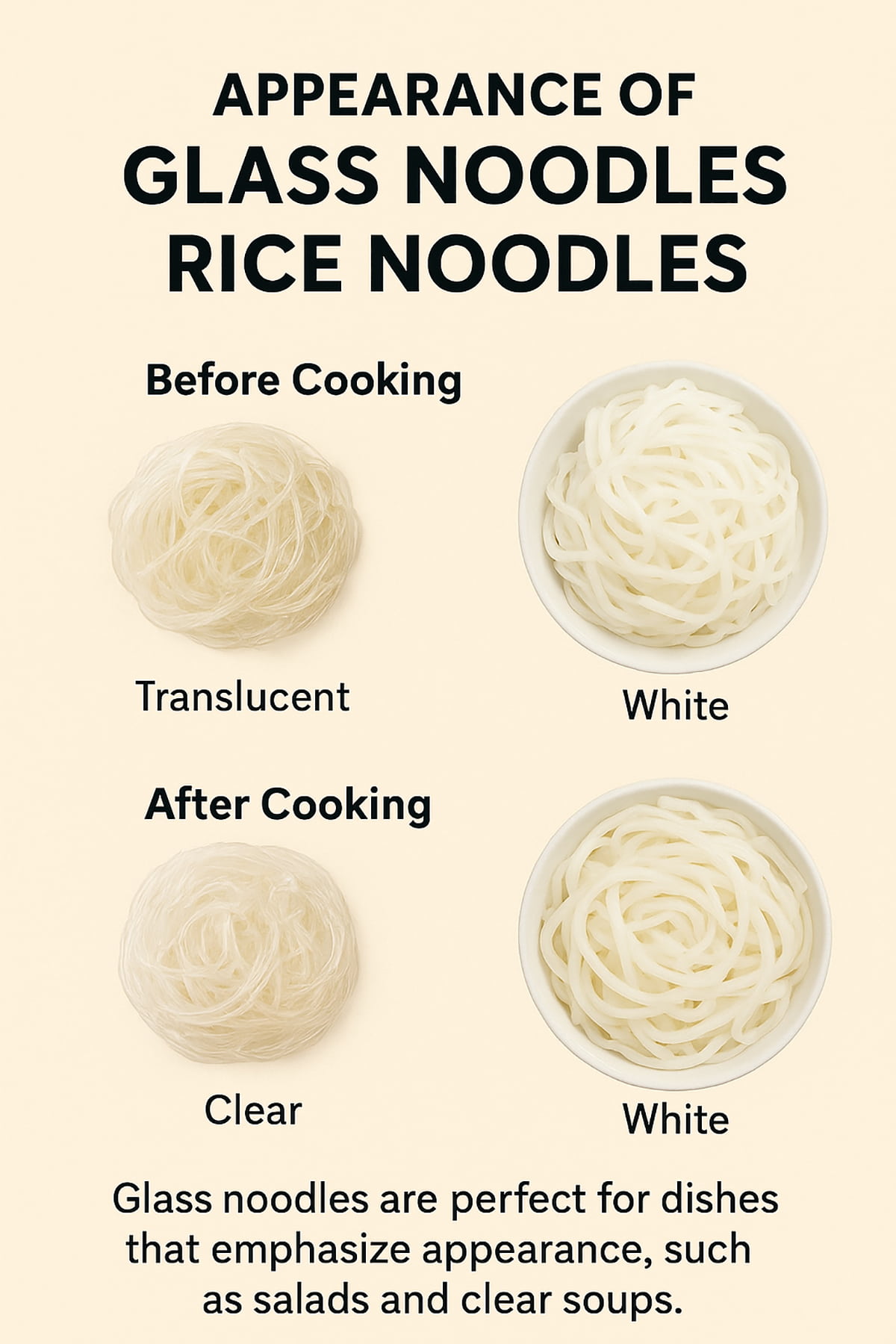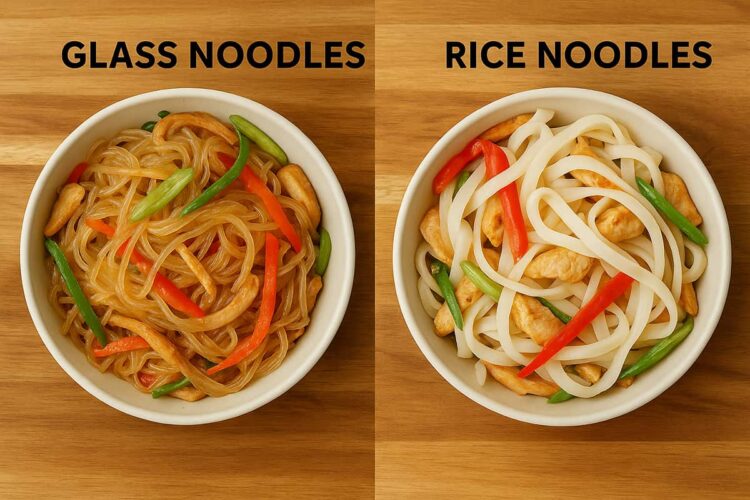One day, I was walking through a bustling Asian market, the air filled with the aromas of dishes that filled my nostrils. Every time I looked away, I saw woks full of sizzling noodles with fresh ingredients. Among the noodles being cooked, glass noodles and rice noodles caught my eye. At first glance, both seem similar, but actually have differences between glass noodles vs rice noodles in flavors, stories, and culinary wonders of their own. If you know the difference, you’ll know which one to choose. From soups and stir-fries to cold salads and spring rolls, they all capture your attention and make your culinary taste buds wander wildly.
Okay, to understand the difference, I’ll show you both types of noodles. I’ve tried them before, so I know the taste, savory flavor, and aroma. Below, I’ll show you the ingredients used to make glass noodles and rice noodles.
Ingredients
Glass noodles are sometimes also known as cellophane noodles or bean thread noodles. They are noodles made from tapioca, bean starch, and potato starch. According to legend, a Chinese family accidentally discovered glass noodles while experimenting with starch, producing transparent noodles that amazed their neighbors with their appearance and texture. Another story goes that a curious cook experimented with various starches, creating the glass noodles we know today.
Meanwhile, rice noodles are noodles made from rice flour mixed with water, resulting in a white, opaque appearance. Rice noodles also have their own unique story, as it is said that a street vendor in Thailand refined the rice noodles over generations, soaking and drying them meticulously to achieve the ideal chewy texture still enjoyed today. [seriouseats.com]
Appearance of Glass Noodles Vs Rice Noodles

Raw rice noodles are white and remain white after cooking. Glass noodles, on the other hand, are translucent before cooking and become clear after boiling or soaking.
This difference in appearance makes glass noodles the perfect noodle for dishes that emphasize appearance, such as salads and clear soups.
Textural Differences
Glass noodles have a slippery, jelly-like texture, making them suitable for soups and cold dishes. Rice noodles have a denser, chewier texture, making them ideal for stir-fries like Pad Thai and noodle soups, which require noodles to absorb flavors well.
Calories and Nutrition
Nutritionally, the two are also different. Glass noodles are lower in calories and carbohydrates. One cup of cooked glass noodles contains about 160 calories, while the same portion of rice noodles contains 190 calories. Both are fat-free and cholesterol-free. However, another difference is that rice noodles, while high in calories, are also enriched with protein. [healthline.com]
For low-carb diets like the Keto diet, glass noodles are a great choice.
Cooking Methods
The two also differ in cooking methods. Rice noodles are known for their versatility. They can be boiled, soaked, or stir-fried. Meanwhile, glass noodles are usually soaked in water and then cooked. Glass noodles are great for hot pot, spring rolls, Korean japchae, and other Asian recipes that emphasize texture.
Some Recipe Ideas for Glass Noodles and Rice Noodles
- Glass Noodle Salad: Mix soaked glass noodles with fresh vegetables, herbs, and a soy-sesame dressing.
- Stir-Fried Rice Noodles: Typically, rice noodles are cooked with chicken, shrimp, vegetables, and a tangy sauce for a quick meal.
- Add to Hot Pot Recipes: Use glass noodles to add texture and absorb the flavors of the simmering broth.
- Add to Pad Thai: Rice noodles are the classic choice for this beloved stir-fry, beautifully soaking up the sweet-savory sauce.
Similarities
Although there are many differences between the two, there are similarities that often confuse many people. This is also why I differentiate between glass noodles vs rice noodles.
Both glass noodles and rice noodles are gluten-free and can be prepared quickly. Both are suitable for meal plans and are also great as accompaniments to Asian dishes.
Cooking Tips for Both Noodles
Cooking glass noodles should always begin by soaking them in warm water for 5 to 10 minutes. This ensures a good texture and meets your expectations.
Don’t overcook rice noodles. Boil or soak them until they are soft and slightly mushy. When cooking, you can combine them with fresh vegetables, protein-rich ingredients like eggs or chicken breast, and a sauce of your choice to enhance the flavor and nutrition.
Check out more:
FAQs for Glass Noodles vs Rice Noodles
Q: Can I substitute glass noodles for rice noodles?
A: Yes, you can, but pay attention to the texture. Glass noodles are more slippery like jelly, while rice noodles are firmer. So, understand the texture first so you can imagine the results.
Q: Which noodle is better for low-carb diets?
A: Glass noodles are low in carbohydrates and calories, so they are the best choice for those on a low-carb diet.
Q: Are both noodles gluten-free?
A: Yes, both are gluten-free. However, when purchasing them, I recommend always checking the package, especially the ingredients.
Q: How long do glass noodles take to cook?
A: Usually, we soak them for 5 to 10 minutes before cooking. This depends on the recipe.
Conclusion
While glass noodles and rice noodles may appear similar, their differences in ingredients, texture, appearance, and cooking methods make each unique. Choosing between glass noodles vs rice noodles depends on the dish you are preparing and your dietary needs. Both noodles are versatile, gluten-free, quick to prepare, and can be the star of many delicious Asian recipes.
However, for those of you who are on a low-carb diet, the choice is Glass Noodles.














